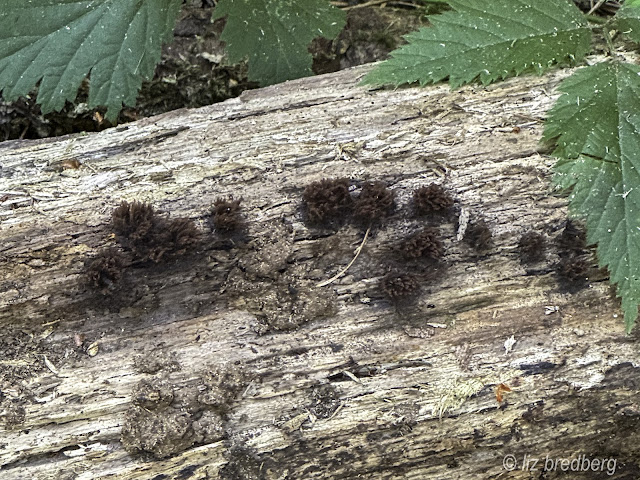28 July
The Forest and Wetlands are dry, but ripening.
Cat-tail moss, once lush, is now fading. Typically, mosses are re-invigorated by moisture, but the rainy season is still at least a month away, and likely further.
The fungus that grew on this alder snag has dried.
Despite the drought, new growth, such as this mushroom, is appearing.
These strange little clusters of dark moss have just emerged. I'm hoping for help in identifying them.
Plants which bloomed recently are now producing seeds and fruit.
The pathfinder is showing its odd flowers and seed pods.
The abundant foamflower has dried,
and is now producing its distinctive seedpods.
Nipplewort is showing its seedheads--fluff, with an oblong seed.
Salal berries are ripening.
Trillium produce sticky seeds from an egg-shaped pod.
Attracted to the sticky seeds, ants aid in their dispersion.
The "mystery seedlings" that we'd hoped to identify by watching their maturation have perished in the dry weather.
It's possible that more seedlings will emerge from the nurse log in time. We'll monitor the log.
A new candidate for the recently collapsed woodpecker stump has appeared.
It looks as though the Marsh is doing what it does best: retaining water in the peat, and keeping water in the surrounding vegetation.
Frogs, even bullfrogs, are still small. They watch the dock's visitors attentively.
It's likely that the frogs are watching for dragonflies, which abound in this season. There are some forty species of dragonfly recorded in the Marsh. This is a four-spotted skimmer.
Leaving the Marsh and Forest, once again we saw the fine meeting of sunlight and moss.
It's an endless delight. What will next week offer us?




















Comments
Post a Comment